Time and Frequency Domains Analysis of Chipless RFID Back-Scattered Tag Reflection
Abstract
:1. Introduction
2. Theory
2.1. A Chipless RFID System
2.2. Equivalent Circuit Model of a Multi-Resonator Chipless RFID Tag
2.2.1. Single Resonator Model
2.2.2. Multi-Resonator Transfer Function
3. Results
3.1. Simulation Results
3.2. Equivalent Circuit Model
3.3. Time-Domain of the Equivalent Model
3.4. Measurement Results
4. Conclusions
Author Contributions
Funding
Acknowledgments
Conflicts of Interest
References
- Preradovic, S.; Karmakar, N.C. Chipless RFID: Bar Code of the Future. IEEE Microw. Mag. 2010, 11, 87–97. [Google Scholar] [CrossRef]
- Mulloni, V.; Donelli, M. Chipless RFID Sensors for the Internet of Things: Challenges and Opportunities. Sensors 2020, 20, 2135. [Google Scholar] [CrossRef] [PubMed] [Green Version]
- Martinez, M.; van der Weide, D. Compact single-layer depolarizing chipless RFID tag. Microw. Opt. Technol. Lett. 2016, 58, 1897–1900. [Google Scholar] [CrossRef]
- Pöpperl, M.; Parr, A.; Mandel, C.; Jakoby, R.; Vossiek, M. Potential and Practical Limits of Time-Domain Reflectometry Chipless RFID. IEEE Trans. Microw. Theory Tech. 2016, 64, 2968–2976. [Google Scholar] [CrossRef]
- Paredes, F.; Herrojo, C.; Mata-Contreras, J.; Moras, M.; Núñez, A.; Ramon, E.; Martín, F. Near-field chipless radio-frequency identification (RFID) sensing and identification system with switching reading. Sensors 2018, 18, 1148. [Google Scholar] [CrossRef] [Green Version]
- Babaeian, F.; Feng, J.; Karmakar, N. Realisation of a High Spectral Efficient Chipless RFID Tag using Hairpin Resonators. In Proceedings of the 2019 IEEE Asia-Pacific Microwave Conference (APMC), Singapore, 10–13 December 2019; pp. 114–116. [Google Scholar]
- Abdulkawi, W.M.; Sheta, A.-F.A.; Issa, K.; Alshebeili, S.A. Compact printable inverted-M shaped chipless RFID tag using dual-polarized excitation. Electronics 2019, 8, 580. [Google Scholar] [CrossRef] [Green Version]
- Ma, Z.; Jiang, Y. High-density 3D printable chipless RFID tag with structure of passive slot rings. Sensors 2019, 19, 2535. [Google Scholar] [CrossRef] [PubMed] [Green Version]
- Alam, J.; Khaliel, M.; Fawky, A.; El-Awamry, A.; Kaiser, T. Frequency-Coded Chipless RFID Tags: Notch Model, Detection, Angular Orientation, and Coverage Measurements. Sensors 2020, 20, 1843. [Google Scholar] [CrossRef] [Green Version]
- Nguyen, D.H.; Zomorrodi, M.; Karmakar, N.C. Spatial-Based Chipless RFID System. IEEE J. Radio Freq. Identif. 2019, 3, 46–55. [Google Scholar] [CrossRef]
- Vena, A.; Perret, E.; Tedjini, S. Chipless RFID Tag Using Hybrid Coding Technique. IEEE Trans. Microw. Theory Tech. 2011, 59, 3356–3364. [Google Scholar] [CrossRef]
- Babaeian, F.; Karmakar, N.C. Hybrid Chipless RFID Tags—A Pathway to EPC Global Standard. IEEE Access 2018, 6, 67415–67426. [Google Scholar] [CrossRef]
- Jiménez-Sáez, A.; Alhaj-Abbas, A.; Schüßler, M.; Abuelhaija, A.; El-Absi, M.; Sakaki, M.; Samfaß, L.; Benson, N.; Hoffmann, M.; Jakoby, R.; et al. Frequency-Coded mm-Wave Tags for Self-Localization System Using Dielectric Resonators. J. Infrared Millim. Terahertz Waves 2020, 41, 908–925. [Google Scholar] [CrossRef]
- Abbas, A.A.-H.; Abuelhaija, A.; Solbach, K. Investigation of the transient EM scattering of a dielectric resonator. In Proceedings of the 2018 11th German Microwave Conference, Freiburg, Germany, 12–14 March 2018; Volume 2018, pp. 271–274. [Google Scholar]
- Babaeian, F.; Karmakar, N. Development of Cross-Polar Orientation-Insensitive Chipless RFID Tags. IEEE Trans. Antennas Propag. 2020, 68, 5159–5170. [Google Scholar] [CrossRef]
- Abdulkawi, W.M.; Sheta, A.-F.A. K-State Resonators for High-Coding-Capacity Chipless RFID Applications. IEEE Access 2019, 7, 185868–185878. [Google Scholar] [CrossRef]
- Manekiya, M.; Donelli, M.; Kumar, A.; Menon, S.K. A novel detection technique for a chipless RFID system using quantile regression. Electronics 2018, 7, 409. [Google Scholar] [CrossRef] [Green Version]
- Babaeian, F.; Karmakar, N. A Cross-Polar Orientation Insensitive Chipless RFID Tag. In Proceedings of the 2019 IEEE International Conference on RFID Technology and Applications (RFID-TA), Pisa, Italy, 25–27 September 2019; pp. 116–119. [Google Scholar]
- Machac, J.; Polivka, M.; Svanda, M.; Havlicek, J. Reducing mutual coupling in chipless rfid tags composed of U-folded dipole scatterers. Microw. Opt. Technol. Lett. 2016, 58, 2723–2725. [Google Scholar] [CrossRef]
- Polivka, M.; Havlicek, J.; Svanda, M.; Machac, J. Improvement in Robustness and Recognizability of RCS Response of U-Shaped Strip-Based Chipless RFID Tags. IEEE Antennas Wirel. Propag. Lett. 2016, 15, 2000–2003. [Google Scholar] [CrossRef]
- Machac, J.; Boussada, A.; Svanda, M.; Havlicek, J.; Polivka, M. Influence of Mutual Coupling on Stability of RCS Response in Chipless RFID. Technologies 2018, 6, 67. [Google Scholar] [CrossRef] [Green Version]
- Kalansuriya, P.; Karmakar, N. Time domain analysis of a backscattering frequency signature based chipless RFID tag. In Proceedings of the Asia-Pacific Microwave Conference 2011, Melbourne, VIC, Australia, 5–8 December 2011; pp. 183–186. [Google Scholar]
- Rance, O.; Perret, E.; Siragusa, R.; Lemaitre-Auger, P. RCS Synthesis for Chipless RFID: Theory and Design; Elsevier: Amsterdam, The Netherlands, 2017. [Google Scholar]
- Aliasgari, J.; Karmakar, N.C. Mathematical Model of Chipless RFID Tags for Detection Improvement. IEEE Trans. Microw. Theory Tech. 2020. [Google Scholar] [CrossRef]
- Babaeian, F.; Forouzandeh, M.M.; Karmakar, N. Solving a Chipless RFID Inverse Problem Based on Tag Range Estimation. IET Microw. Antennas Propag. 2020. [Google Scholar] [CrossRef]
- Babaeian, F.; Karmakar, N.C. A High Gain Dual Polarized Ultra-Wideband Array of Antenna for Chipless RFID Applications. IEEE Access 2018, 6, 73702–73712. [Google Scholar] [CrossRef]
- Vena, A.; Perret, E.; Tedjini, S. Chipless RFID Based on RF Encoding Particle: Realization, Coding and Reading System; ISTE Press-Elsevier: London, UK; Oxford, UK, 2016. [Google Scholar]
- El-Hadidy, M.; El-Awamry, A.; Fawky, A.; Khaliel, M.; Kaiser, T. Real-world testbed for multi-tag UWB chipless RFID system based on a novel collision avoidance MAC protocol. Trans. Emerg. Telecommun. Technol. 2016, 27, 1707–1714. [Google Scholar] [CrossRef]
- Kalansuriya, P.; Karmakar, N.C.; Viterbo, E. On the Detection of Frequency-Spectra-Based Chipless RFID Using UWB Impulsed Interrogation. IEEE Trans. Microw. Theory Tech. 2012, 60, 4187–4197. [Google Scholar] [CrossRef] [Green Version]
- Ramos, A.; Perret, E.; Rance, O.; Tedjini, S.; Lazaro, A.; Girbau, D. Temporal Separation Detection for Chipless Depolarizing Frequency-Coded RFID. IEEE Trans. Microw. Theory Tech. 2016, 64, 2326–2337. [Google Scholar] [CrossRef]
- Vena, A.; Perret, E.; Tedjni, S. A Depolarizing Chipless RFID Tag for Robust Detection and Its FCC Compliant UWB Reading System. IEEE Trans. Microw. Theory Tech. 2013, 61, 2982–2994. [Google Scholar] [CrossRef]
- Hassanpour, H.; Zehtabian, A.; Sadati, S. Time domain signal enhancement based on an optimized singular vector denoising algorithm. Digit. Signal Process. 2012, 22, 786–794. [Google Scholar] [CrossRef]
- Islam, M.A.; Karmakar, N.C. A Novel Compact Printable Dual-Polarized Chipless RFID System. IEEE Trans. Microw. Theory Tech. 2012, 60, 2142–2151. [Google Scholar] [CrossRef]
- Santiago, J.M. Circuit Analysis for Dummies, 1st ed.; John Wiley & Sons: Hoboken, NJ, USA, 2013. [Google Scholar]
- Terman, F.E. Radio Engineers’ Handbook; McGraw-Hill: New York, NY, USA, 1943. [Google Scholar]
- Cohn, S.B. Slot line on a dielectric substrate. IEEE Trans. Microw. Theory Tech. 1969, 17, 768–778. [Google Scholar] [CrossRef]
- Salehi, M.; Manteghi, M. Transient Characteristics of Small Antennas. IEEE Trans. Antennas Propag. 2014, 62, 2418–2429. [Google Scholar]
- Ross, R. Radar cross section of rectangular flat plates as a function of aspect angle. IEEE Trans. Antennas Propag. 1966, 14, 329–335. [Google Scholar] [CrossRef]

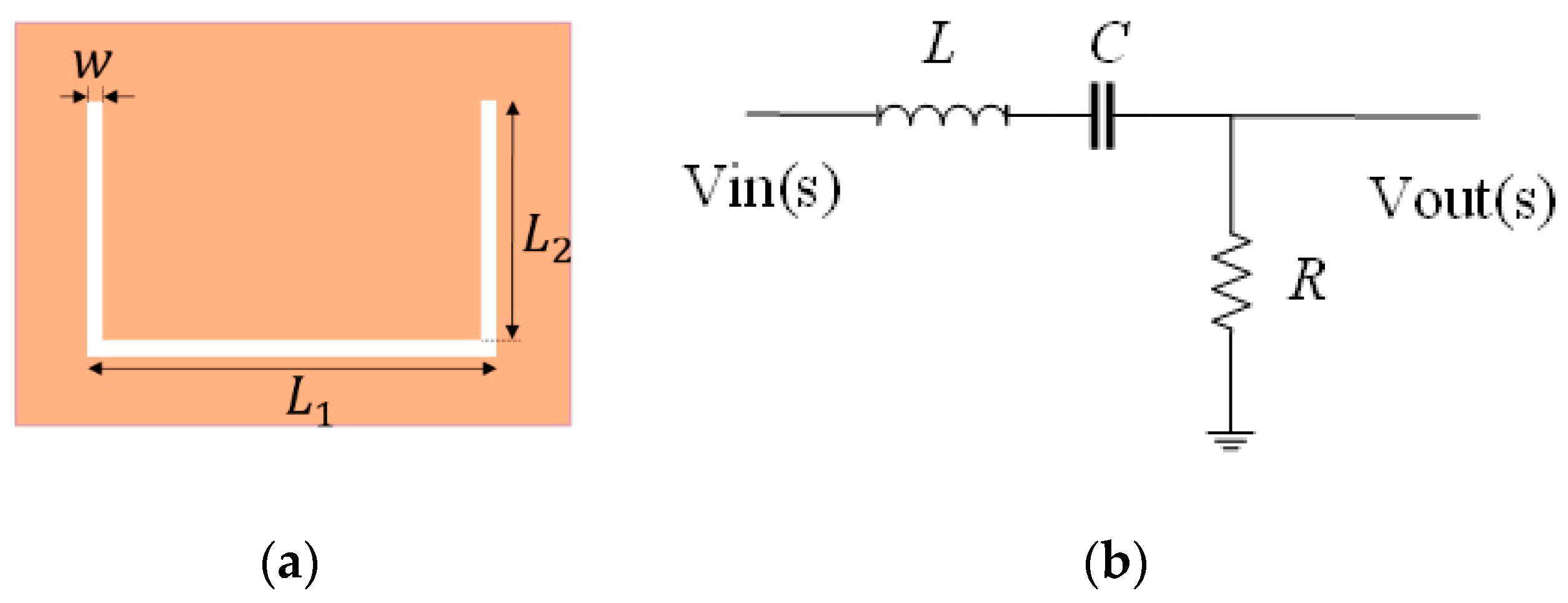
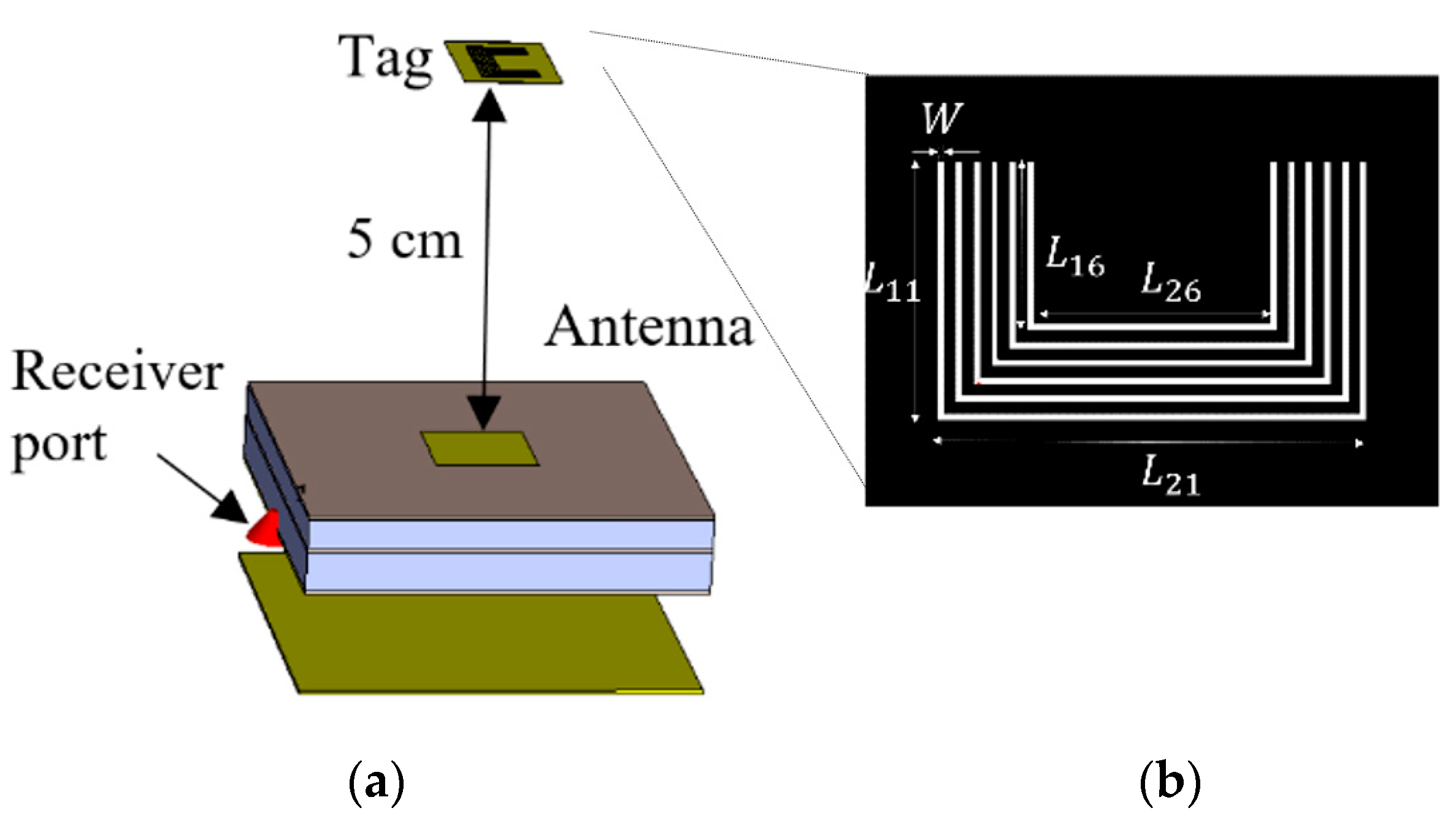
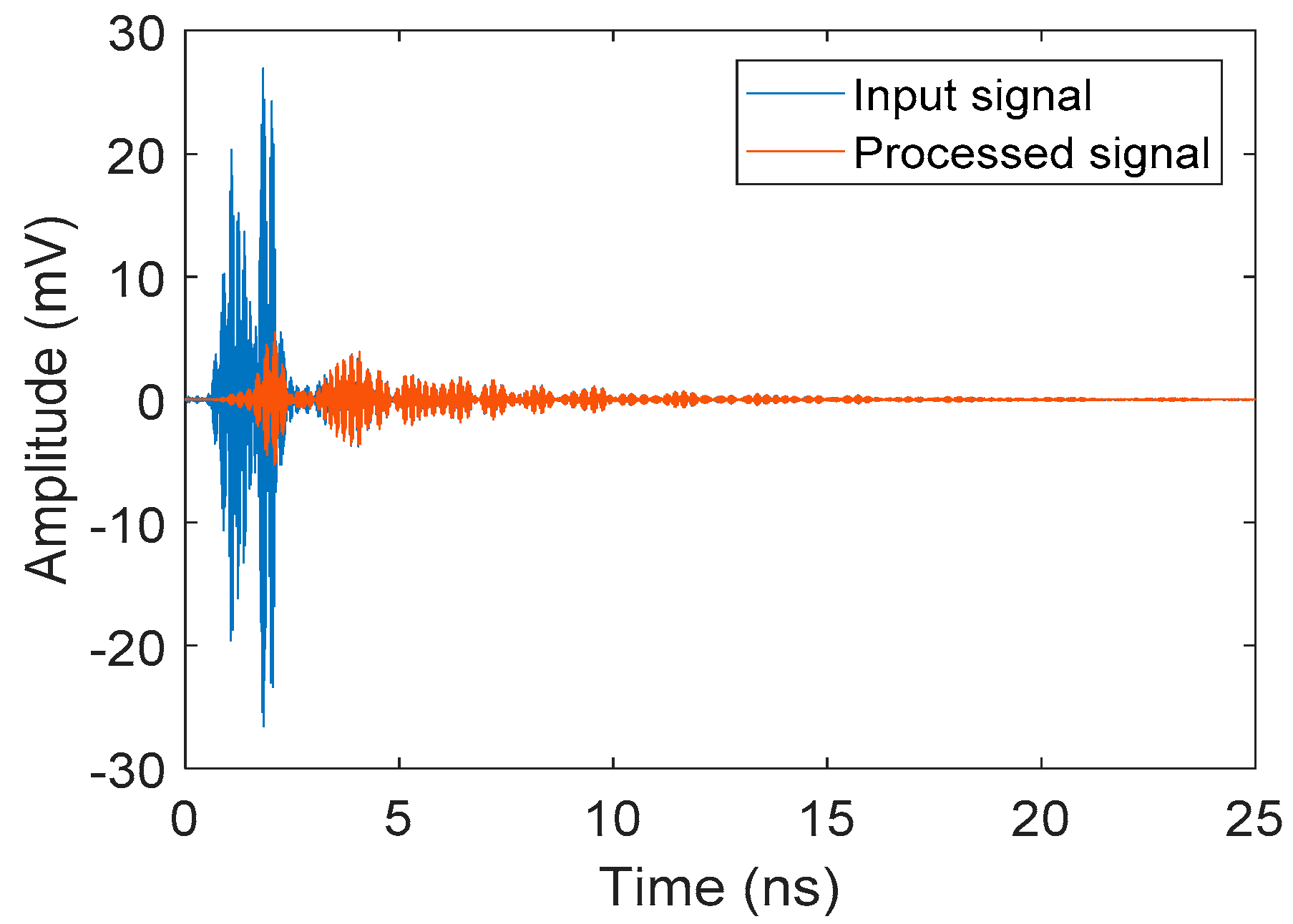

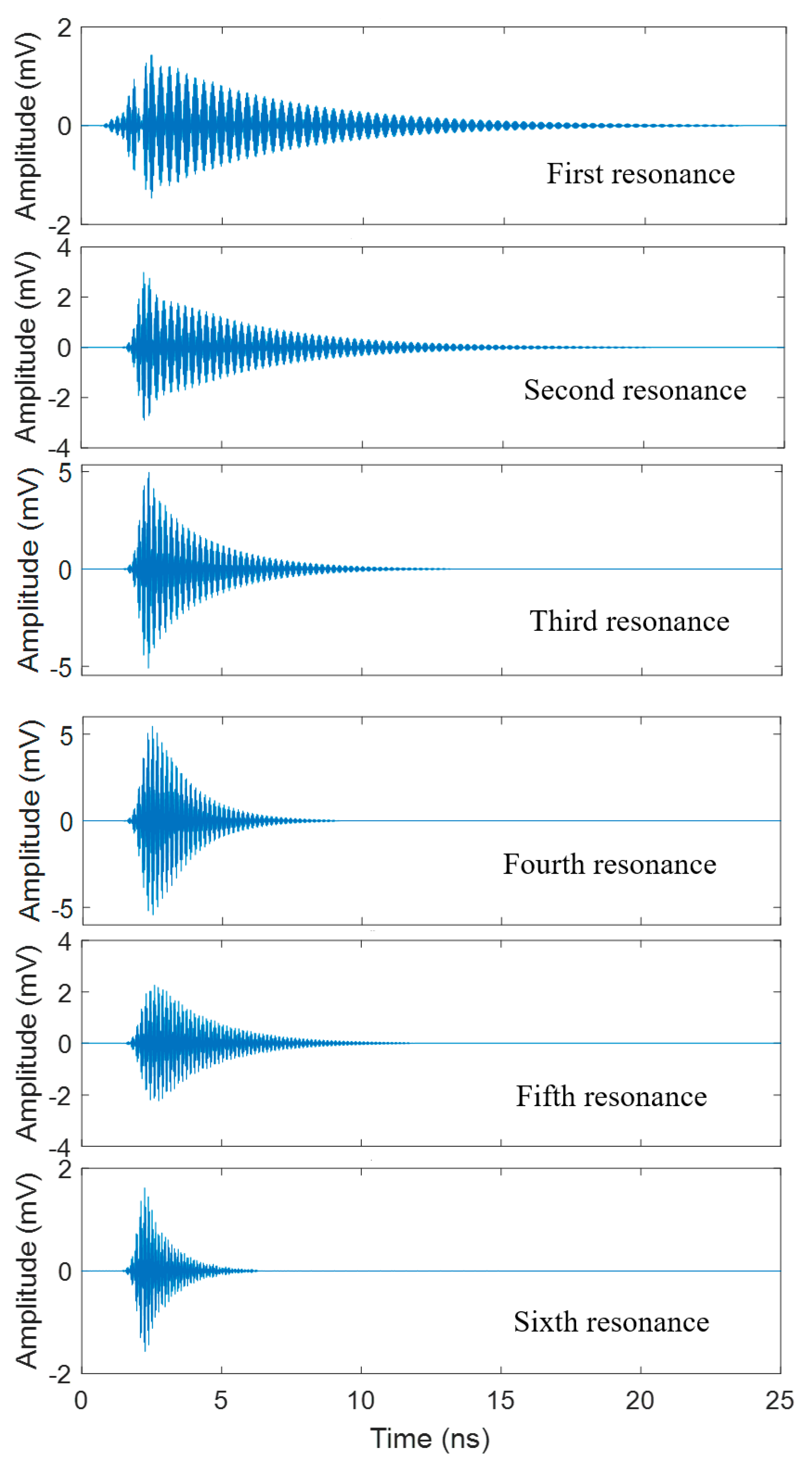


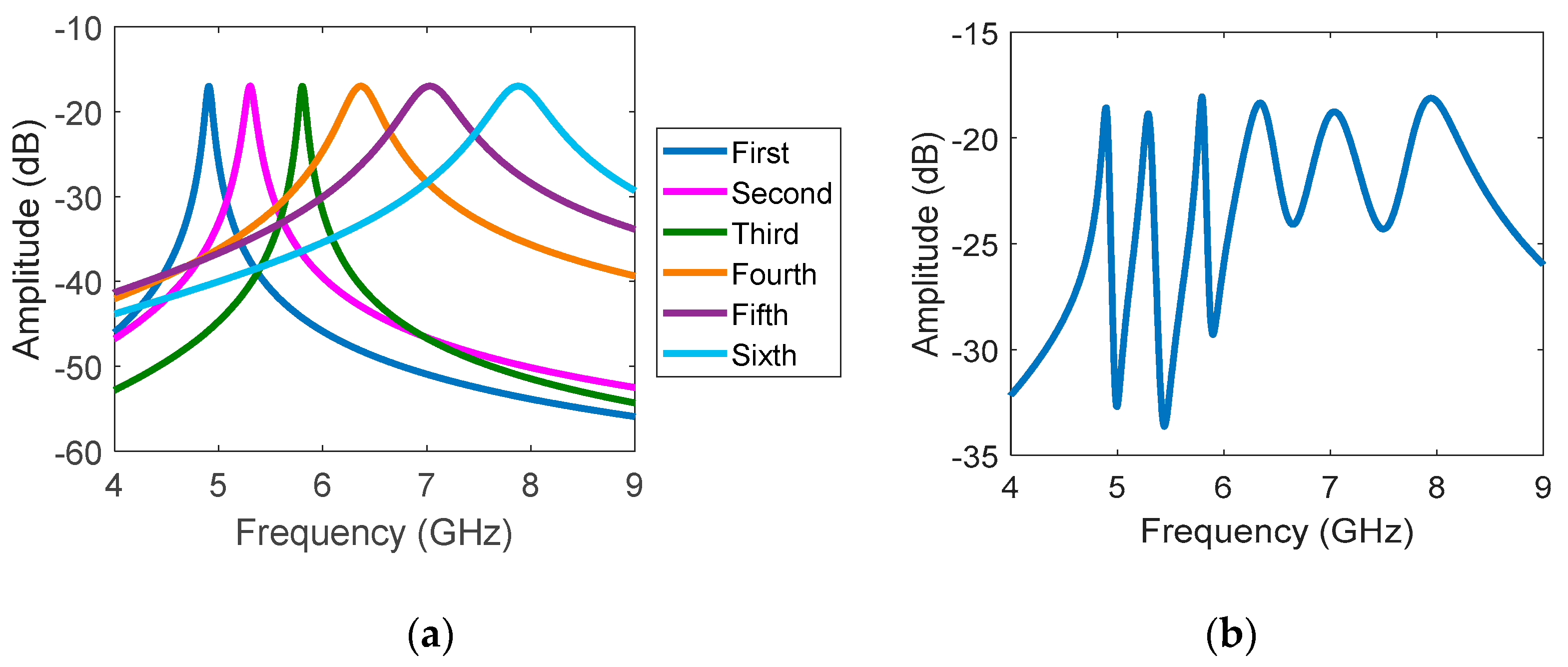
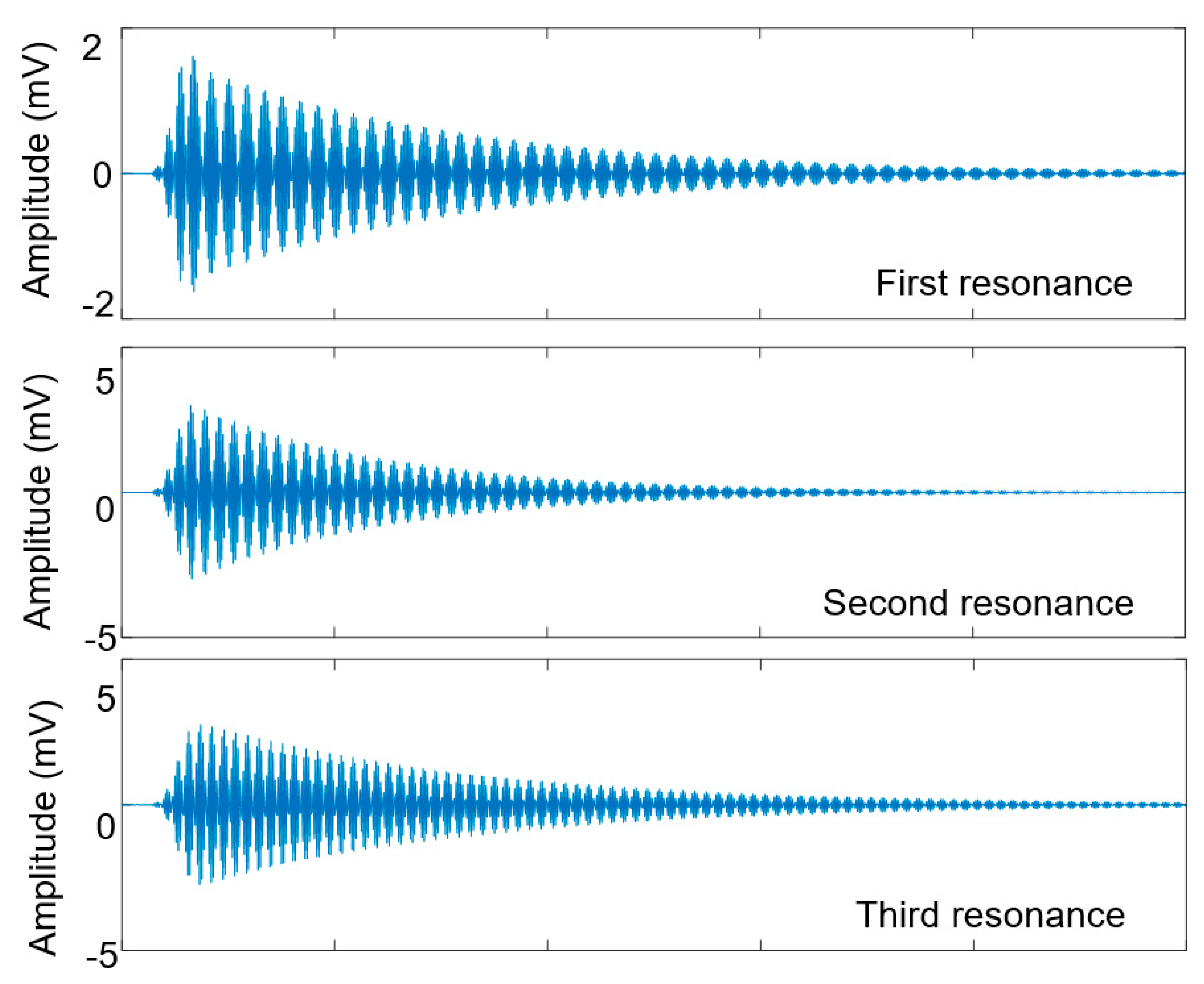


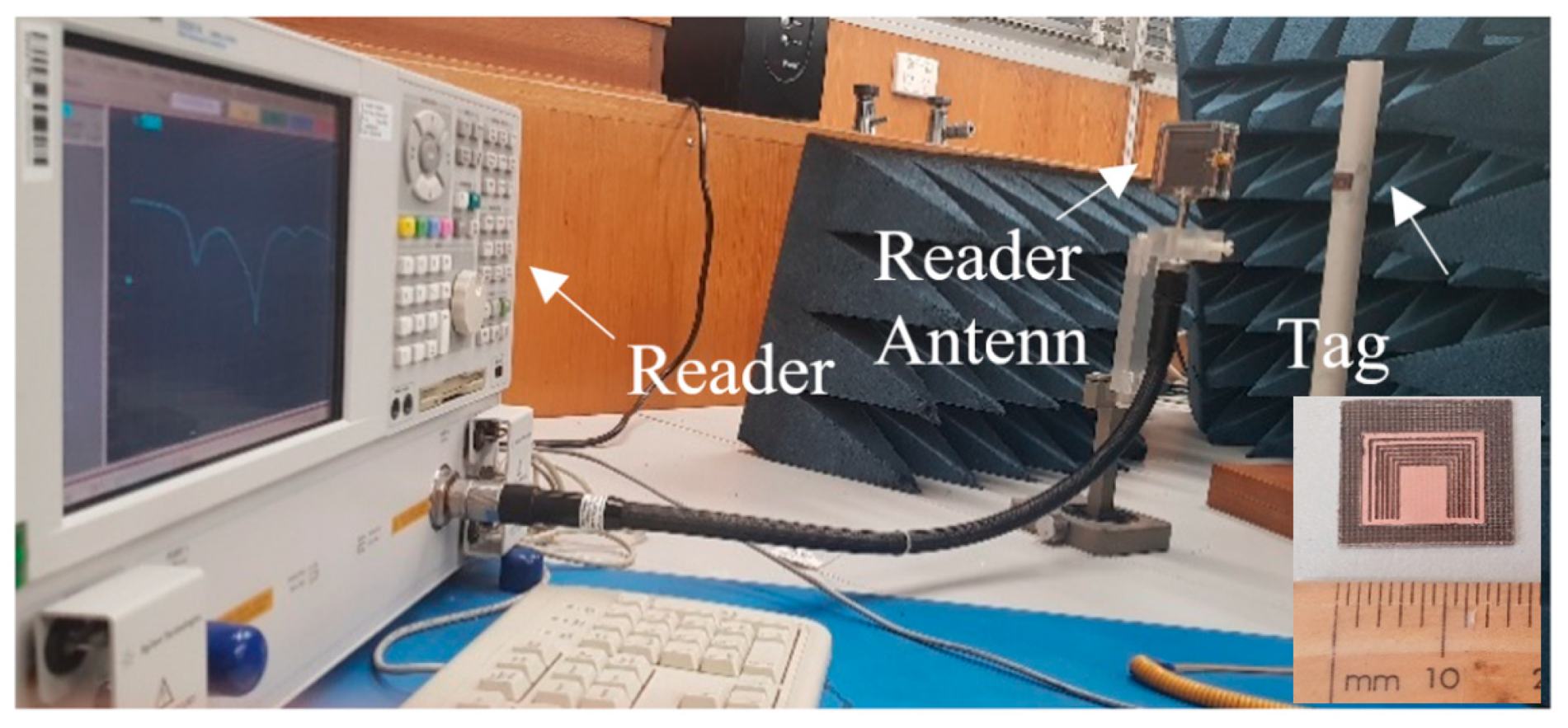

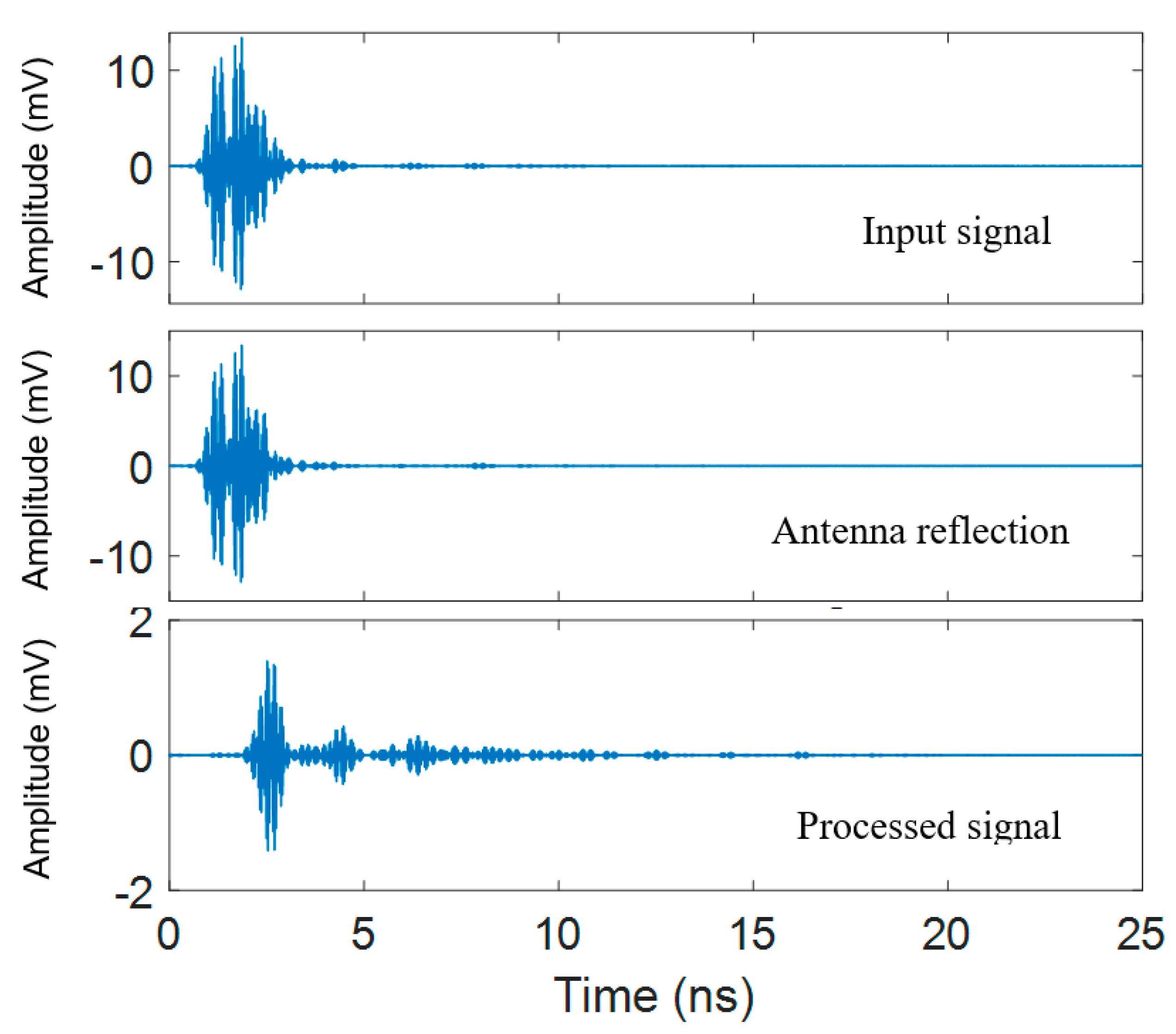
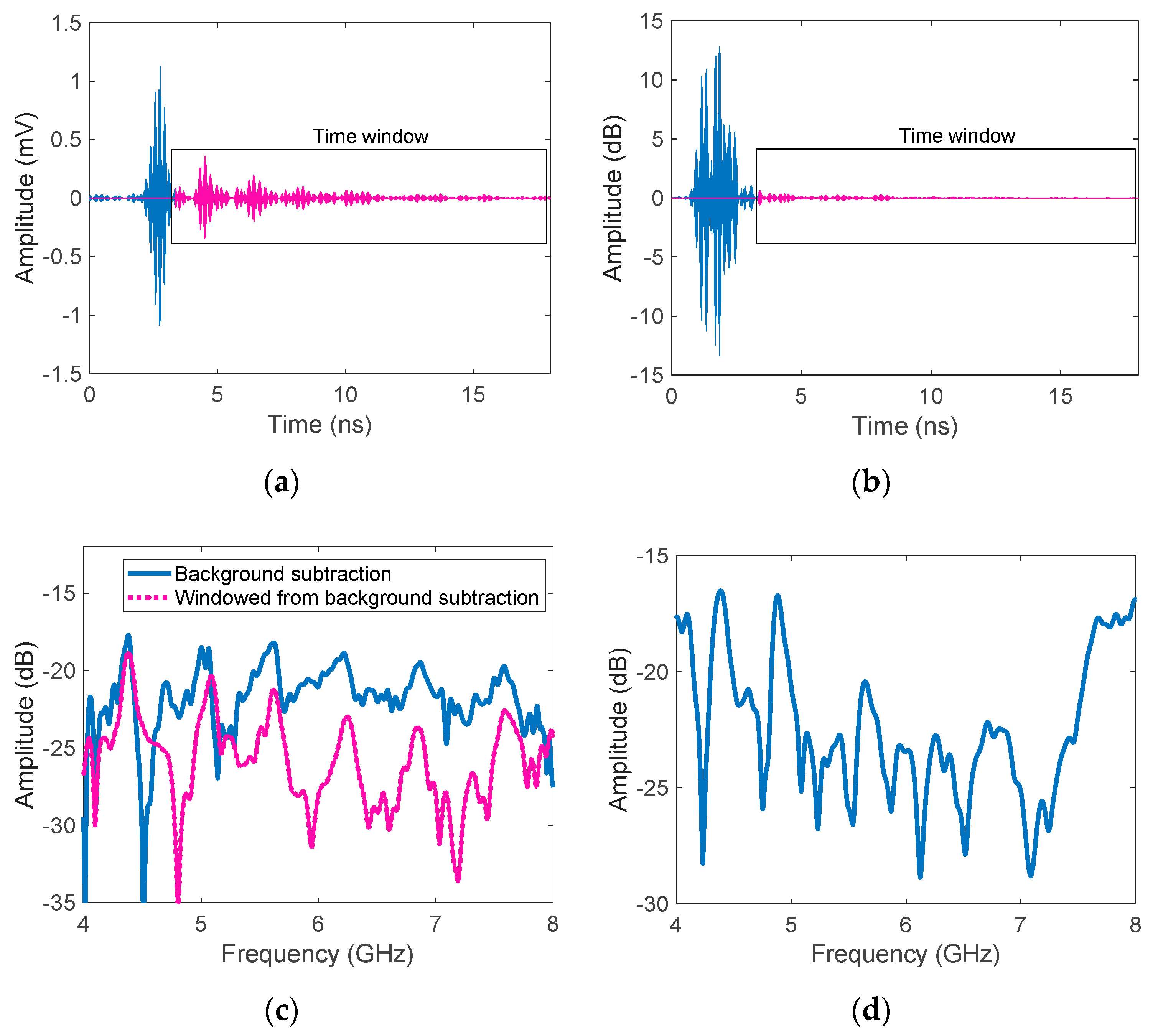
| Individual Resonators | Combined Resonators | ||||||||||
|---|---|---|---|---|---|---|---|---|---|---|---|
| Order | Frequency (GHz) | 3-dB Bandwidth (MHz) | Q-Factor | Peak-Null Variation (dB) | Group Delay (ns) | Physical Length (mm) | Frequency (GHz) | 3-dB Bandwidth (MHz) | Q-Factor | Peak-Null Variation (dB) | Group Delay (ns) |
| 1st | 4.926 | 75 | 65.6 | 30.35 | 31.52 | 25.6 | 4.8 | 48 | 100 | 20.24 | 40.8 |
| 2nd | 5.34 | 98 | 54.4 | 21.18 | 25.87 | 23.6 | 5.22 | 64 | 81.5 | 19.76 | 36.57 |
| 3rd | 5.796 | 161 | 36 | 20.96 | 190 | 21.6 | 5.7 | 115 | 48.5 | 21.99 | 34.86 |
| 4th | 6.342 | 332 | 19.1 | 42.12 | 17.36 | 16.6 | 6.258 | 121 | 51.7 | 21.98 | 42.93 |
| 5th | 7.014 | 474 | 14.7 | 24.3 | 18.12 | 17.6 | 6.69 | 136 | 49.19 | 19.78 | 26.76 |
| 6th | 7.866 | 522 | 15 | 23.54 | 18.93 | 15.6 | 7.974 | 253 | 34.66 | 24.81 | 16.4 |
| Order | |||||
|---|---|---|---|---|---|
| 1st | 0.1098 | 0.0494 | 0.958 | 4.5 | 0.95 |
| 2nd | 0.0988 | 0.0613 | 0.912 | 6.2 | 1.11 |
| 3rd | 0.0880 | 0.0396 | 0.854 | 4.5 | 1.33 |
| 4th | 0.0622 | 0.1343 | 1.006 | 21.6 | 1.6 |
| 5th | 0.0672 | 0.215 | 0.763 | 32 | 1.95 |
| 6th | 0.0572 | 0.1887 | 0.714 | 33 | 2.45 |
© 2020 by the authors. Licensee MDPI, Basel, Switzerland. This article is an open access article distributed under the terms and conditions of the Creative Commons Attribution (CC BY) license (http://creativecommons.org/licenses/by/4.0/).
Share and Cite
Babaeian, F.; Karmakar, N.C. Time and Frequency Domains Analysis of Chipless RFID Back-Scattered Tag Reflection. IoT 2020, 1, 109-127. https://doi.org/10.3390/iot1010007
Babaeian F, Karmakar NC. Time and Frequency Domains Analysis of Chipless RFID Back-Scattered Tag Reflection. IoT. 2020; 1(1):109-127. https://doi.org/10.3390/iot1010007
Chicago/Turabian StyleBabaeian, Fatemeh, and Nemai Chandra Karmakar. 2020. "Time and Frequency Domains Analysis of Chipless RFID Back-Scattered Tag Reflection" IoT 1, no. 1: 109-127. https://doi.org/10.3390/iot1010007





